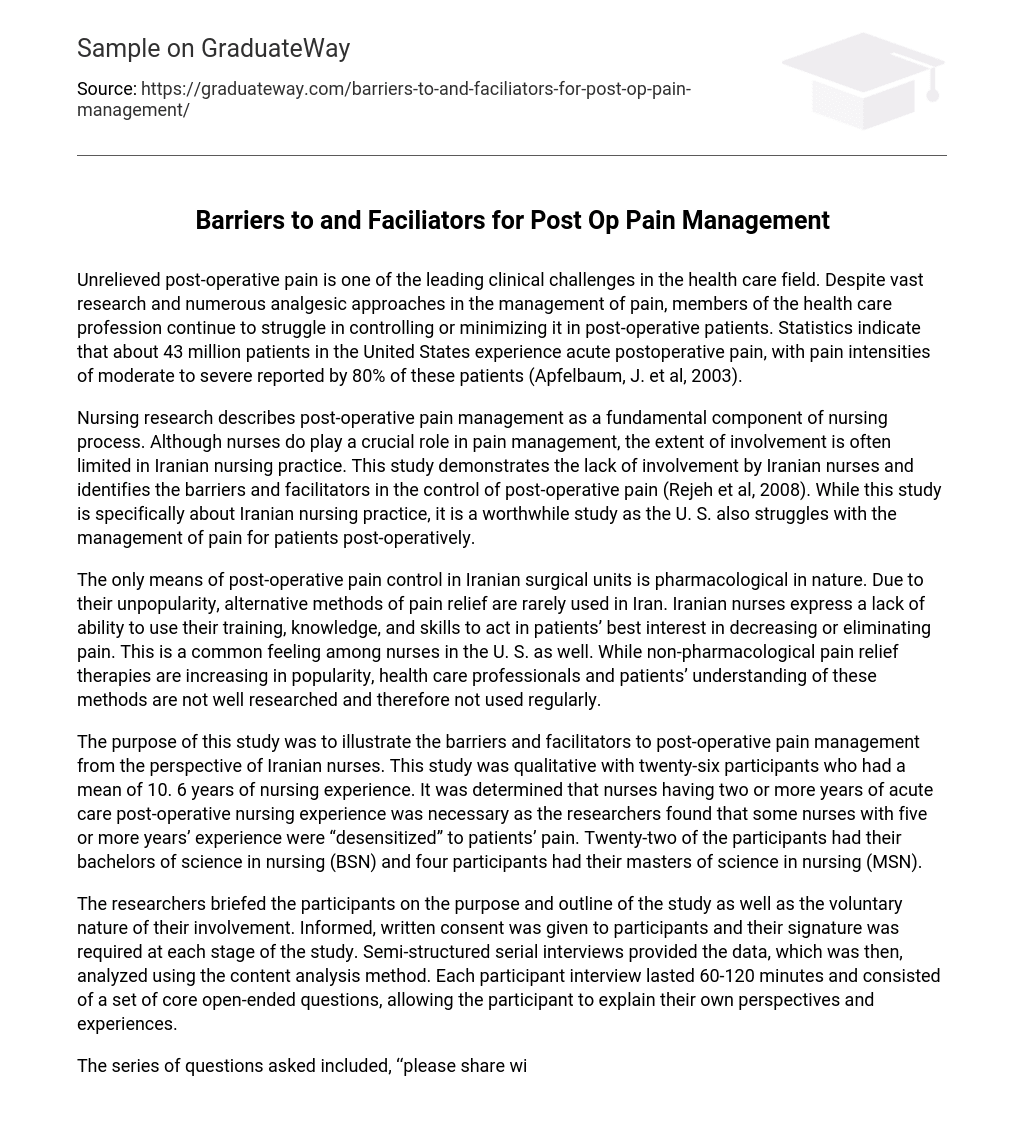Despite extensive research and various strategies to manage pain, uncontrolled or reduced pain after surgery remains a significant challenge in healthcare. In the United States, approximately 43 million patients suffer from acute postoperative pain, with around 80% of them reporting moderate to severe pain intensity (Apfelbaum, J. et al, 2003).
The significance of post-operative pain management in the nursing process is emphasized by nursing research. However, in Iranian nursing practice, nurses’ participation in this area is often restricted. A study conducted by Rejeh et al. (2008) uncovers the limited involvement of Iranian nurses in controlling post-operative pain and identifies both obstacles and facilitating factors. While this study primarily examines Iranian nursing practice, it also holds relevance as managing pain for post-operative patients remains a challenge in the U.S.
In Iranian surgical units, pharmaceuticals are the sole means employed for pain management post-surgery. Non-pharmacological methods are not extensively utilized in Iran due to their lack of popularity. Similar to nurses in the U.S., Iranian nurses also feel inadequate in effectively alleviating patients’ pain with their training and expertise. Although non-pharmacological approaches for pain relief are becoming more popular, there is limited research and understanding among healthcare professionals and patients regarding these techniques, resulting in infrequent utilization.
This study aimed to examine the challenges and factors that impact the management of post-operative pain among Iranian nurses. Twenty-six participants, with an average nursing experience of 10.6 years, were included in the study. The findings indicated that having a minimum of two years’ experience in acute care for post-operative patients was crucial, as it was observed that some nurses with five or more years of experience had become “desensitized” to patients’ pain. Among the participants, twenty-two held a bachelors of science in nursing (BSN) degree, while four possessed a masters of science in nursing (MSN) degree.
Participants were provided with an overview of the study’s purpose and structure, as well as informed about their voluntary participation. Written consent was obtained from them throughout the study. The data was gathered through semi-structured serial interviews and examined using content analysis. These interviews varied in duration from 60 to 120 minutes and consisted of a set of core open-ended questions that enabled participants to share their viewpoints and experiences.
In a study conducted by Rejeh et al in 2008, participants were asked a series of questions regarding their approach to caring for patients experiencing pain. These questions sought to gather information on successful and unsuccessful efforts in managing patient pain. The responses were then analyzed, and the participants received a transcript of their interviews along with a summary highlighting the themes that emerged from the analysis. This was done to determine if the codes and themes resonated with their own experiences.
This study identified several factors that either hindered or facilitated post-operative pain management. The themes were divided into two main categories: barriers to pain management after surgery and facilitators of pain management. The barriers category included subgroups such as powerlessness, organizational policies and rules, physician leadership, time constraints, limited communication with patients and/or physicians, and interruptions in pain-related activities.
The second theme focused on promoting post-operative pain management, consisting of elements such as the nurse-patient relationship, nurses’ responsibility, the physician as a colleague, and nurses’ knowledge and skills (Rejeh, 2008). It is not surprising that addressing patients’ post-operative pain management has been a longstanding challenge for medical personnel, with limited success. To alleviate this issue, fostering collaborative, respectful, and professional relationships between physicians and nurses would be beneficial.
In Iran, nurses face difficulties in building professional relationships with patients due to the prominent authority of physicians and their tendency to take charge. To foster trust and collaboration, nurses would greatly benefit from having a suitable nurse-to-patient ratio. This would allow them to effectively comprehend and address each patient’s unique pain relief requirements. Additionally, it is crucial for nurses to possess the requisite knowledge and abilities in order to make informed decisions regarding the most efficient pain management techniques and their appropriate timing.
Despite multiple studies highlighting the insufficient pain management for surgical patients and the underlying causes, the lack of research on effective solutions remains a challenge. Although researchers and medical professionals comprehend the reasons behind persistent post-operative pain, it seems difficult to find feasible solutions within Iran’s medical system and the current state of healthcare reform in America. Each physician and nurse acknowledges the significance of pain control following surgery; however, effectively implementing and sustaining these measures continues to be an unresolved matter.
References
The article “Postoperative Pain Experience: Results From a National Survey Suggest Postoperative Pain Continues to be Undermanaged” by Apfelbaum, J., Chen, C., Mehta, S., and Gan, T. (2003), as well as the paper “Nurses’ Attitudes, Knowledge, and Use of Nonpharmalogical Pain Management Techniques And Therapies” by Bicek, E. (2004), both discuss the management of postoperative pain. The first article emphasizes the undermanagement of postoperative pain based on a national survey, while the second paper explores nurses’ attitudes, knowledge, and utilization of nonpharmalogical pain management techniques.
Retrieved December 2, 2012, from http://digitalcommons. iwu. edu/nursing_honproj/12 Rejeh, N. N. , Ahmadi, F. F. , Mohammadi, E. E. , Anoosheh, M. M. , & Kazemnejad, A. A. (2008). Barriers to And Facilitators of Post-Operative Pain Management in Iranian Nursing: a Qualitative Research Study. International Nursing Review, 55(4), 468-475. Retrieved December 2, 2012, from http://ehis. ebscohost. com. library. gcu. edu:2048/ehost/pdfviewer/pdfviewer? sid=f992456e-4001-4729-b8cd-6f2710a56e5f%40sessionmgr12&vid=5&hid=4





